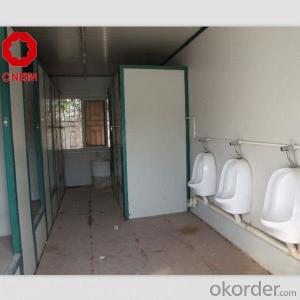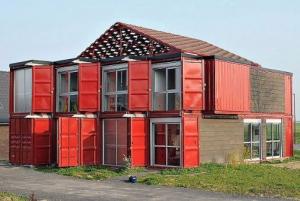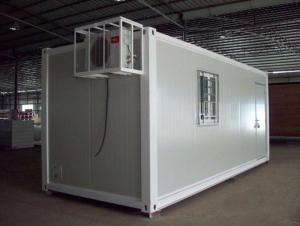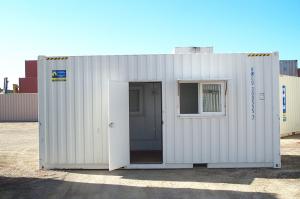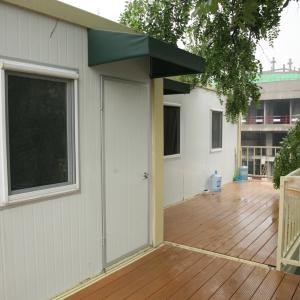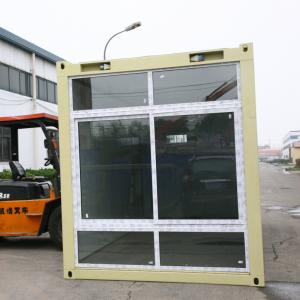Container House for Living Office Toilet Bathroom Shower
- Loading Port:
- Tianjin
- Payment Terms:
- TT OR LC
- Min Order Qty:
- 1 set
- Supply Capability:
- 1000 set/month
OKorder Service Pledge
OKorder Financial Service
You Might Also Like
Container House with Prefabricated House ;Movable Container House :
mobile container hotel house
Movable Container House :
20ft Container House,Movable House,Prefab House,Mobile House,Modular House,Low-cost Office,Toilet,Shower
Specification: 5910*2438*2591mm
No. | Part Name | Material |
1 | Foundation | Square Tube |
2 | Corner Post | Steel |
3 | Floor Beam | C Shape Steel |
4 | Roof Beam | C Shape Steel |
5 | Connection Plate | Steel |
6 | Edge Covering | Steel Plate |
7 | Wall | Sandwich Panel, optional |
8 | Flooring | Plywood+Vinyl Flooring/Laminate Flooring, optional |
9 | Roof | Corrugated Sandwich Panel, optional |
10 | Door | Sandwich Panel with aluminum doorframe |
11 | Doorlock | Stainless Steel |
12 | Window | Plastic Steel or Aluminum |
Plan:
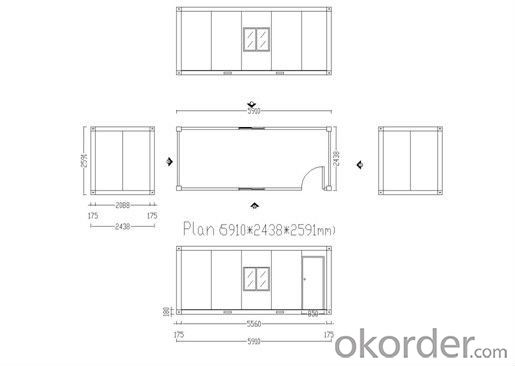

- Q:Can container houses be designed with a modern or contemporary aesthetic?
- Yes, container houses can definitely be designed with a modern or contemporary aesthetic. In fact, many architects and designers have embraced the use of shipping containers as a sustainable and affordable building material, while also incorporating sleek and stylish designs. One of the advantages of using container houses for modern or contemporary designs is their clean and industrial look. The metal structure of the containers, with their straight lines and geometric shapes, can lend themselves well to a modern aesthetic. Additionally, the uniformity of the containers allows for modular design, which can be easily customized to create a contemporary look. Designers often incorporate large windows, open floor plans, and minimalist interiors to enhance the modern feel of container houses. This allows for abundant natural light, an airy atmosphere, and a seamless integration between indoor and outdoor spaces. The use of high-quality finishes, such as wood or polished concrete, can further elevate the overall contemporary aesthetic of the container house. Moreover, container houses can be creatively stacked or arranged to create unique and visually striking designs. Architects have experimented with cantilevered sections, rooftop gardens, and even multi-story container structures, all of which contribute to a modern and cutting-edge appearance. Ultimately, container houses offer a versatile canvas for modern or contemporary designs. With the right architectural vision and attention to detail, these structures can be transformed into stylish and visually appealing homes that seamlessly blend sustainability and aesthetics.
- Q:Are container houses customizable in terms of size?
- Yes, container houses are customizable in terms of size. The modular nature of shipping containers allows for easy modification and customization to fit specific requirements. Container houses can be expanded or reduced in size by adding or removing containers, and can also be stacked or joined together to create larger living spaces. This flexibility in sizing makes container houses a popular choice for those looking for a custom-built and unique living space.
- Q:Can container houses be designed for retail or pop-up shops?
- Yes, container houses can definitely be designed and repurposed for retail or pop-up shops. Their modular nature allows for easy customization and conversion, making them an ideal choice for temporary or mobile businesses. Container houses can be transformed into trendy and cost-effective retail spaces, offering unique and eye-catching aesthetics while maintaining functionality and practicality. With some modifications, such as adding windows, doors, insulation, and interior fixtures, container houses can be transformed into attractive and versatile spaces for retail or pop-up shops.
- Q:Can container houses be built with efficient water-saving features?
- Yes, container houses can definitely be built with efficient water-saving features. In fact, container houses offer a great opportunity to incorporate various water-saving measures due to their compact and modular nature. One common feature in container houses is the use of low-flow plumbing fixtures, such as low-flow toilets, showerheads, and faucets. These fixtures are designed to reduce water consumption without compromising functionality. Additionally, dual-flush toilets can be installed, allowing for different water volume options depending on the need. Another efficient water-saving feature that can be incorporated into container houses is rainwater harvesting. The roof of the container can be equipped with a system that collects rainwater and stores it in tanks. This harvested water can then be used for non-potable purposes such as irrigation, toilet flushing, and laundry. By utilizing rainwater, container houses can significantly reduce their reliance on municipal water sources. Greywater recycling is another effective water-saving feature that can be integrated into container houses. Greywater refers to water from sinks, showers, and washing machines that can be reused for purposes other than drinking, such as irrigation or toilet flushing. Greywater recycling systems filter and treat the water to make it safe for reuse, reducing the overall water consumption of the house. Furthermore, container houses can incorporate efficient landscaping practices, such as drought-tolerant plants and smart irrigation systems. These practices aim to minimize water usage for outdoor areas and ensure that water is only applied when necessary. Overall, container houses can be designed and built with various water-saving features, including low-flow fixtures, rainwater harvesting, greywater recycling, and efficient landscaping. These features not only reduce water consumption but also contribute to sustainable living and environmental preservation.
- Q:Are container houses suitable for eco-friendly living?
- Container houses can indeed be a suitable option for eco-friendly living. These houses are made from repurposed shipping containers, which reduces the demand for new construction materials and minimizes waste. By reusing these containers, we are effectively recycling and reducing the carbon footprint associated with traditional housing construction. Additionally, container houses can be designed to be energy-efficient. With proper insulation and ventilation systems, these houses can effectively regulate temperature, reducing the need for excessive heating or cooling. This helps to conserve energy and lower greenhouse gas emissions. Furthermore, container houses lend themselves well to incorporating sustainable features. They can be equipped with solar panels to generate clean, renewable energy, reducing reliance on fossil fuels. Rainwater harvesting systems can also be installed, enabling homeowners to collect and reuse water, conserving this valuable resource. Container houses also promote sustainable living by encouraging minimalist lifestyles. The limited space within these houses encourages individuals to declutter and live with less, reducing consumption and waste. This minimalist approach aligns well with eco-friendly living principles. However, it is important to note that the sustainability of container houses is also dependent on the materials and practices used during the conversion process. It is essential to ensure that eco-friendly materials are used for insulation, flooring, and finishes, and that the conversion process itself is carried out in an environmentally responsible manner. Overall, container houses can be a suitable option for eco-friendly living. They offer the benefits of recycling and reducing waste, energy efficiency, and the potential for incorporating sustainable features. However, it is important to consider the entire lifecycle of the house, from construction to ongoing maintenance, to ensure that it truly aligns with eco-friendly living principles.
- Q:Can container houses be designed with a meditation or yoga space?
- Yes, container houses can be designed with a meditation or yoga space. The versatility and flexibility of container homes allow for customization and the inclusion of specific spaces tailored to individual needs and preferences. With thoughtful planning and design, a container house can easily incorporate a dedicated area for meditation or yoga, providing a tranquil and peaceful environment for these practices.
- Q:Are container houses suitable for individuals with allergies or sensitivities?
- Depending on various factors, container houses can be a viable choice for individuals who have allergies or sensitivities. One advantage of these houses is their ability to be constructed using non-toxic and hypoallergenic materials, which can decrease the likelihood of triggering allergies or sensitivities. Additionally, the construction process allows for better control over ventilation, aiding in the filtration of allergens and the maintenance of air quality. Nevertheless, it is essential to take into account the source of the container, as some may have previously transported goods that could have contained allergens or irritants. It is imperative to thoroughly clean and treat the container to ensure it is safe for individuals with allergies or sensitivities. Moreover, the suitability of a container house for individuals with allergies or sensitivities greatly depends on its location and the surrounding environment. If the house is situated in an area with high levels of pollen, dust, or other allergens, it may still present challenges. Therefore, it is crucial to consider factors such as the local climate, air quality, and potential exposure to allergens when contemplating a container house for someone with allergies or sensitivities. Ultimately, determining whether a container house is appropriate for individuals with allergies or sensitivities requires careful consideration of these factors, utilization of proper construction techniques, and the incorporation of hypoallergenic materials to establish a safe and healthy living environment.
- Q:Are container houses fireproof?
- Container houses are not inherently fireproof, but they have the potential to become fire-resistant through the implementation of appropriate construction techniques and materials. Being constructed from steel, shipping containers possess a higher melting point compared to wood, thus reducing the likelihood of ignition and fire propagation. However, it is crucial to acknowledge that the interior and exterior finishes, insulation, and other components of a container house remain susceptible to fire. To enhance fire resistance, container houses can be equipped with fire-rated materials such as gypsum boards, fire-rated insulation, and fire-resistant coatings. These measures serve the purpose of confining fires and impeding their spread, affording occupants additional time for evacuation and granting emergency responders an extended period to control the situation. Moreover, the installation of fire detectors, alarms, and sprinkler systems can further augment fire safety within container houses. It is important to emphasize that although container houses have the capacity to be made fire-resistant, they are not entirely fireproof. Similar to any other form of residence, they necessitate the implementation of effective fire prevention measures and regular maintenance to minimize the risks associated with fire.
- Q:Are container houses suitable for areas with strict HOA regulations?
- Container houses can be a suitable option for areas with strict HOA regulations, but it will depend on the specific requirements and restrictions set by the HOA. While container houses may not fit the traditional aesthetic of many neighborhoods with HOA regulations, they offer several advantages that can make them a viable option. Firstly, container houses are often more affordable compared to traditional stick-built homes. They can be a cost-effective solution for people looking to build a home in areas with high property prices or limited housing options. This affordability factor may make container houses an attractive option for some homeowners. Secondly, container houses are known for their durability and sustainability. Containers are built to withstand harsh conditions during transportation, which makes them resistant to extreme weather conditions and natural disasters. Additionally, repurposing shipping containers reduces waste and contributes to a more environmentally friendly approach to construction. However, it's important to note that container houses may require some modifications to meet the specific regulations set by the HOA. These modifications can include changes to the exterior appearance, landscaping, or even the overall layout of the house. Homeowners must thoroughly review and understand the HOA guidelines to ensure compliance. Furthermore, it is advisable to engage in open communication with the HOA board and seek their approval before proceeding with a container house project. Demonstrating the benefits, addressing any concerns, and providing detailed plans can help persuade the HOA to consider allowing container houses within their regulations. In conclusion, container houses can be suitable for areas with strict HOA regulations, but it requires careful consideration, adherence to guidelines, and open communication with the HOA. The affordability, durability, and sustainability aspects of container houses can make them an appealing option for homeowners, but it's essential to ensure compliance with the specific regulations set by the HOA.
- Q:How do container houses compare to traditional houses in terms of energy efficiency?
- Container houses are often considered to be more energy-efficient than traditional houses. This is because containers are typically made of strong, durable materials such as steel that have a high level of insulation. This insulation helps to keep the interior temperature stable, reducing the need for heating or cooling systems and thereby saving energy. Moreover, container houses can incorporate sustainable technologies such as solar panels, rainwater harvesting systems, and energy-efficient appliances. These features further enhance their energy efficiency and minimize their environmental impact. In contrast, traditional houses may not have the same level of insulation, leading to heat loss during colder months and increased energy consumption for heating purposes. Additionally, traditional houses often have larger square footage, which means more energy is required to heat or cool the space. However, it is important to note that the energy efficiency of both container houses and traditional houses can vary greatly depending on factors such as design, construction quality, and the use of sustainable practices. Therefore, it is crucial to consider these aspects when comparing the energy efficiency of container houses to traditional houses.
1. Manufacturer Overview |
|
|---|---|
| Location | |
| Year Established | |
| Annual Output Value | |
| Main Markets | |
| Company Certifications | |
2. Manufacturer Certificates |
|
|---|---|
| a) Certification Name | |
| Range | |
| Reference | |
| Validity Period | |
3. Manufacturer Capability |
|
|---|---|
| a)Trade Capacity | |
| Nearest Port | |
| Export Percentage | |
| No.of Employees in Trade Department | |
| Language Spoken: | |
| b)Factory Information | |
| Factory Size: | |
| No. of Production Lines | |
| Contract Manufacturing | |
| Product Price Range | |
Send your message to us
Container House for Living Office Toilet Bathroom Shower
- Loading Port:
- Tianjin
- Payment Terms:
- TT OR LC
- Min Order Qty:
- 1 set
- Supply Capability:
- 1000 set/month
OKorder Service Pledge
OKorder Financial Service
Similar products
New products
Hot products
Related keywords
